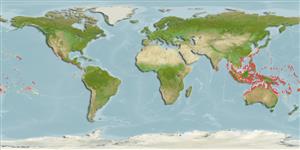Common names from other countries
分类 / Names
俗名 | 同种异名 | Catalog of Fishes(属, 种) | ITIS | CoL | WoRMS | Cloffa
Teleostei >
Blenniiformes (Blennies)
鱸形目 (Blennies) >
Blenniidae (Combtooth blennies) > Blenniinae
Etymology: Aspidontus: Greek, aspis, -idos = shield + Latin, dens, dentis = teeth (Ref. 45335).
More on authors: Quoy & Gaimard.
Environment: milieu / climate zone / depth range / distribution range
生态学
海洋 礁区鱼类; 深度上下限 1 - 25 m (Ref. 90102). 熱帶; 32°N - 32°S
Indo-Pacific.
太平洋: 在東印度洋到列島群島,馬貴斯群島與 Tuamoto 島中的可可群島-基靈群島 (參考文獻 9399) 與聖誕島 (參考文獻 30874), 北至日本南部, 南至新南威爾斯; 在密克羅尼西亞各處。
大小 / 重量 / 年龄
Maturity: Lm ? range ? - ? cm
Max length : 11.5 cm TL 雄鱼/尚未辨别雌雄; (Ref. 9710)
背棘 (总数) : 10 - 12; 背的软条 (总数) : 26 - 28; 臀棘: 2; 臀鳍软条: 25 - 28. Bears an amazing resemblance to the cleaner wrasse, Labroides dimidiatus. Distinguished from L. dimidiatus by the position of its mouth, which is terminal in the wrasse but under the snout in the blenny.
有一个令人惊异的样似清洁工隆头鱼, 裂唇鱼[Labroides dimidiatus] 。 与 L. dimidiatus 区分了藉由它的嘴的位置, 在隆头鱼中是终点但是在吻部下面在黏鱼中。
Adults are found solitary or in small groups (Ref. 90102) in lagoons, subtidal reef flats and outer reef slopes (where it occurs to depths of over 20 m). Often in pairs in empty worm tubes or narrow holes. They mimic the cleaner wrasse Labroides dimidiatus and nip fins, skin and scales of other fishes (Ref. 9710). They even copy the motion of the cleaner wrasse that may induce other fish to come close, then target their scales or mucus for a feed, biting and quickly retreating to the corals before the victim realizes that it was tricked; experienced fish recognize imposters and often give it a chase (Ref. 48636). Diet is supplemented with benthic invertebrates and zooplankton (Ref. 94105). Also feed on tubeworms and demersal fish eggs. Oviparous. Eggs are demersal and adhesive (Ref. 205), and are attached to the substrate via a filamentous, adhesive pad or pedestal (Ref. 94114). Larvae are planktonic, often found in shallow, coastal waters (Ref. 94114).
栖息于舄湖,亚潮间带的礁石平台与外礁斜坡。 (在那里它出现到深度超过 20 公尺) 常见于在空的蠕虫管或狭窄的洞中生活在对中。 拟态清洁工隆头鱼 裂唇鱼〔Labroides dimidiatus〕 而且捏鳍,皮肤与其他鱼的鱼鳞。 (参考文献 9710) 它甚至抄袭可能引诱其他的鱼来结束的清洁工隆头鱼的运动,但是它对于一个吃锁定他们的鳞片或者黏液, 咬而且很快地撤退到珊瑚在受害者了解它被戏弄之前; 富有经验的鱼认识冒充者而且时常给它一个追逐。 (参考文献 48636) 也吃管虫与底棲魚卵。 卵生的.(參考文獻 205) 卵是底棲與聚集在一起的。 (參考文獻 205)
Life cycle and mating behavior
Maturities | 繁殖 | Spawnings | Egg(s) | Fecundities | 仔鱼
Distinct pairing (Ref. 205).太平洋: 在東印度洋到列島群島,馬貴斯群島與 Tuamoto 島中的可可群島-基靈群島 (參考文獻 9399) 與聖誕島 (參考文獻 30874), 北至日本南部, 南至新南威爾斯; 在密克羅尼西亞各處。
Smith-Vaniz, W.F., B.C. Victor and G.R. Allen, 2020. Aggressive mimicry in Aspidontus and Plagiotremus (Pisces: Blenniidae): some mimetic phenotypes are not phylogenetically informative. J. Ocean Sci. Found. 35:118-128. (Ref. 123078)
CITES (Ref. 128078)
Not Evaluated
人类利用
渔业: 商业性; 水族馆: 商业性
工具
特别资料
下载 XML
网络资源
Estimates based on models
Preferred temperature (Ref.
115969): 25.1 - 29.3, mean 28.5 (based on 2575 cells).
Phylogenetic diversity index (Ref.
82804): PD
50 = 0.6250 [Uniqueness, from 0.5 = low to 2.0 = high].
Bayesian length-weight: a=0.00562 (0.00258 - 0.01228), b=3.06 (2.87 - 3.25), in cm Total Length, based on LWR estimates for this (Sub)family-body shape (Ref.
93245).
营养阶层 (Ref.
69278): 3.8 ±0.51 se; based on food items.
回复力 (Ref.
120179): 高度, 族群倍增时间少于 15个月 (Preliminary K or Fecundity.).
Fishing Vulnerability (Ref.
59153): Low vulnerability (10 of 100).
